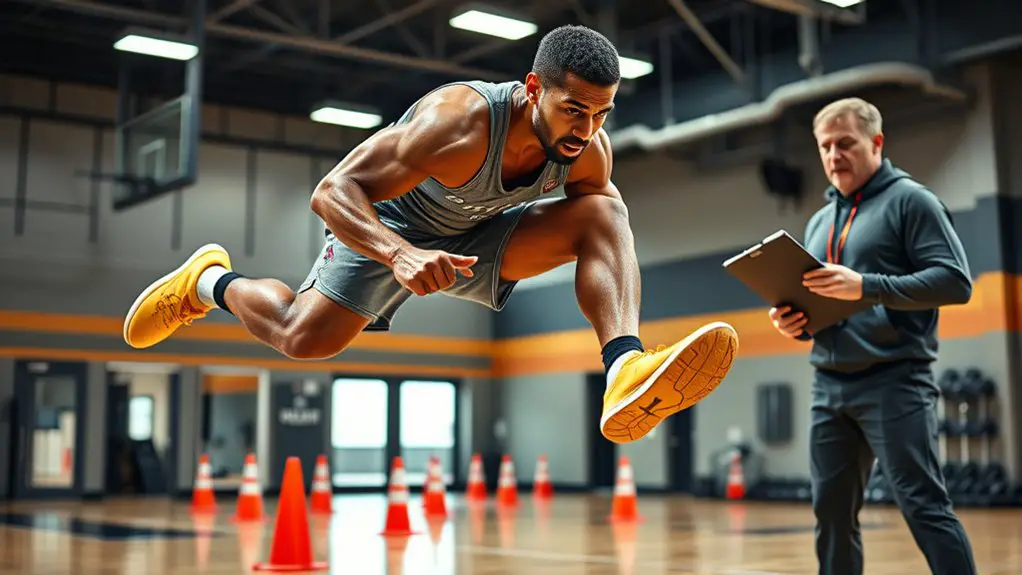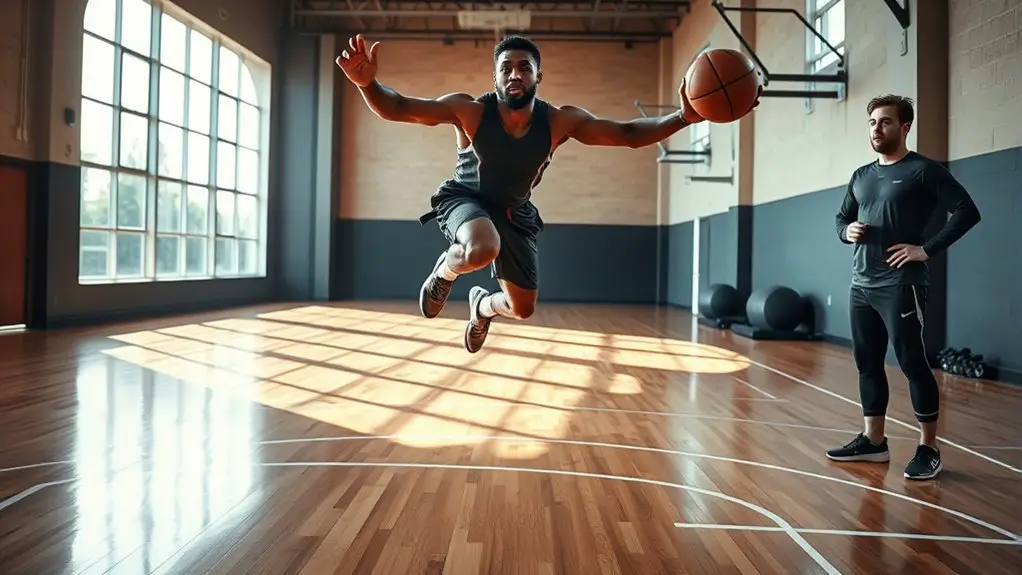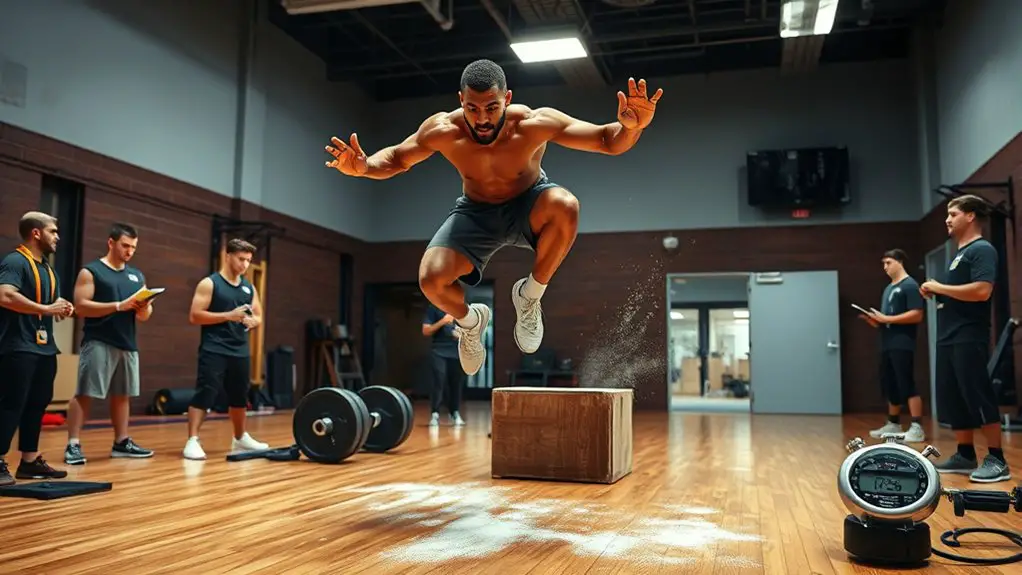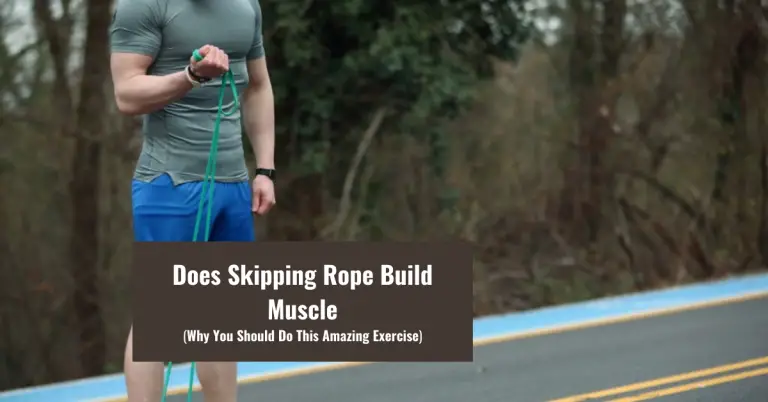How NBA Players Train for Explosiveness

NBA players train for explosiveness through a mix of strength conditioning, plyometrics, and agility drills. They focus on jump mechanics and employ drills to enhance foot speed and vertical jumps. Proper nutrition and hydration are key for performance and recovery. Additionally, mental techniques help maintain focus and motivation while setting achievable goals. Each component works together to maximize explosive potential, setting players apart. Continue on to explore more about these training methods and strategies.
Understanding Explosiveness in Basketball

Explosiveness in basketball is the key to gaining a competitive edge on the court. To harness this power, you need to focus on your jump mechanics. Proper technique is essential, as it helps you maximize your jumping ability while minimizing the risk of injury. When you understand how to position your body and engage your muscles, you’ll achieve more efficient explosive movement.
Start by paying attention to your stance; a balanced, athletic position allows for a more powerful jump. Engage your core and use your legs to generate force, ensuring you’re pushing off the ground effectively. As you practice, incorporate drills that emphasize quick starts and vertical jumps, always prioritizing safety in your movements. Being mindful of your body’s limits will help you develop explosiveness without compromising your well-being. Additionally, incorporating proper technique in your training can enhance knee stability, further supporting your explosive movements. Embrace these fundamentals, and you’ll elevate your game while staying safe on the court.
The Role of Plyometrics in Training
To take your training to the next level, incorporating plyometrics can make a significant difference in your explosive capabilities. These exercises focus on quick, powerful movements that enhance your muscle’s ability to generate explosive power while improving coordination and agility. But safety’s key; always warm up properly and use correct form to prevent injuries.
Here’s a quick overview of plyometric benefits:
| Benefit | Explanation |
|---|---|
| Increased Power | Enhances your vertical jump and sprinting speed. |
| Improved Agility | Boosts your ability to change direction quickly. |
| Enhanced Coordination | Develops better body control and balance. |
| Quick Muscle Response | Trains your muscles to react faster during play. |
Strength Conditioning Techniques

When it comes to enhancing explosiveness, strength conditioning techniques play an essential role. You’ll want to explore both plyometric exercises and weight training protocols that NBA players rely on to maximize their performance. These methods not only build strength but also improve your power output on the court.
Plyometric Exercises Overview
Plyometric exercises are essential for developing the explosive power needed on the basketball court. These jump training techniques enhance your ability to leap higher and move faster while minimizing injury risk. Here are some effective plyometric exercises you can incorporate into your routine:
| Exercise | Focus Area | Safety Tips |
|---|---|---|
| Box Jumps | Lower Body Power | Land softly; use a stable box. |
| Depth Jumps | Reactive Strength | Guarantee proper landing; start low. |
| Split Squat Jumps | Leg Coordination | Maintain balance; keep knees aligned. |
| Tuck Jumps | Core Activation | Engage your core; avoid overextending. |
Weight Training Protocols
Incorporating effective weight training protocols is essential for enhancing strength and explosiveness on the court. To guarantee safety while maximizing performance, consider these key weightlifting strategies for your resistance training routine:
- Focus on Compound Movements: Exercises like squats and deadlifts engage multiple muscle groups, promoting overall strength.
- Prioritize Form Over Weight: Proper technique prevents injuries and guarantees you’re targeting the right muscles.
- Incorporate Olympic Lifts: Movements like cleans and snatches develop power and explosiveness.
- Use Progressive Overload: Gradually increase weights to challenge your muscles while allowing adequate recovery.
Agility Drills for Enhanced Performance
Agility drills are essential for improving your performance on the court. By incorporating ladder drills, cone techniques, and plyometric exercises, you can enhance your footwork and reaction time. Let’s explore how each of these drills can elevate your game.
Ladder Drills Importance
When it comes to enhancing on-court performance, ladder drills play an essential role in developing explosiveness and agility. These exercises provide numerous ladder benefits that can greatly contribute to your game. Here are four key advantages of incorporating ladder drills into your training routine:
- Improved Foot Speed: Quick movements build the foundation for explosive plays.
- Agility Enhancement: You’ll enhance your ability to change directions rapidly, vital during games.
- Coordination Boost: Ladder drills help synchronize your upper and lower body movements.
- Injury Prevention: Strengthening stabilizing muscles reduces the risk of common injuries.
Cone Drills Techniques
After mastering ladder drills, adding cone drills to your training can further elevate your explosiveness and agility on the court. Cone placements are essential for maximizing the effectiveness of these drills. Start with simple patterns, like a T-drill or zigzag, and progressively incorporate drill variations to challenge yourself. Be certain you’re using cones that won’t tip over easily to prevent injuries. Focus on your footwork and maintain proper body alignment to guarantee safety while performing these drills. As you advance, consider adjusting the distance between cones for added intensity. Remember, it’s important to warm up beforehand and stay hydrated, so you can perform at your best without risking injury during these agility-enhancing exercises.
Plyometric Agility Exercises
Incorporating plyometric agility exercises into your training routine can greatly boost your on-court performance. These exercises enhance your jumping techniques and explosive movements, helping you become a more dynamic player. Safety should always be your priority, so start gradually and focus on proper form. Here are four effective plyometric agility exercises to evaluate:
- Box Jumps: Jump onto a sturdy platform, landing softly to absorb the impact.
- Lateral Bounds: Leap side to side, landing on one foot to improve stability and speed.
- Depth Jumps: Step off a box and immediately jump upon landing for enhanced explosiveness.
- Tuck Jumps: Jump high while bringing your knees to your chest, focusing on height and control.
Stay safe and enjoy your training!
Incorporating Speed Workouts
To maximize explosiveness on the court, athletes often focus on speed workouts that enhance their quickness and agility. Incorporating speed training into your regimen can greatly improve your performance. Start with sprint intervals, alternating between short, intense bursts of speed and periods of active recovery. This method not only builds speed but also helps prevent injuries by conditioning your muscles and joints.
When you engage in these workouts, it’s essential to prioritize proper form and warm up adequately to minimize strain. Consider using cones or markers to create a controlled environment for your sprints, ensuring you maintain a safe distance while pushing your limits.
Also, remember to incorporate flexibility and mobility drills into your routine, as they can aid in recovery and further enhance your speed. By consistently integrating these elements, you’ll be well on your way to achieving explosiveness on the court.
Nutrition and Recovery for Optimal Results

While training for explosiveness is essential, the role of nutrition and recovery can’t be overlooked. Proper nutritional timing and effective recovery strategies can greatly enhance your performance and reduce injury risks. Here are four key elements to focus on:
Training for explosiveness is vital, but nutrition and recovery are equally crucial for peak performance and injury prevention.
- Pre-Workout Nutrition: Fuel your body with carbohydrates and proteins before workouts to maximize energy levels.
- Post-Workout Recovery: Consume a balanced meal rich in protein and carbs within 30 minutes after training to promote muscle repair.
- Hydration: Stay well-hydrated throughout the day to optimize performance and support recovery.
- Sleep and Rest: Prioritize quality sleep and incorporate rest days into your routine to allow your body to heal and adapt.
Mental Training for Explosive Performance
As you focus on developing explosiveness, don’t underestimate the power of mental training in enhancing your performance. Mental visualization is an essential tool; by imagining yourself executing explosive moves, you can strengthen your neural pathways and boost your confidence. Picture yourself jumping higher or sprinting faster—this mental rehearsal can translate into real-world performance.
Incorporating focus techniques is equally important. When you’re in practice or a game, concentrate on your breathing and maintain a clear intention for each movement. This helps you stay grounded and reduces anxiety, allowing you to perform at your best.
Additionally, setting specific goals can sharpen your mental clarity. Visualizing your objectives daily can keep you motivated and focused on achieving your explosive potential. Remember, a strong mindset complements your physical training, ensuring you’re prepared to release your full power safely and effectively.
Frequently Asked Questions
How Often Do NBA Players Train for Explosiveness Each Week?
NBA players typically train for explosiveness several times a week, balancing their training frequency and workout intensity. You’ll often find them engaging in explosive drills, strength training, and plyometric exercises, usually around four to six times weekly. It’s essential to listen to your body and prioritize safety, ensuring you’ve got proper recovery time between sessions. This approach helps maintain peak performance while minimizing the risk of injury during intense training periods.
What Equipment Do Players Typically Use for Explosiveness Training?
When you’re focusing on explosiveness training, you’ll often find players using plyometric boxes and resistance bands. Plyometric boxes help improve jump height and power, allowing for controlled landings to minimize injury risk. Resistance bands are great for adding extra tension during exercises, enhancing strength without compromising safety. Remember, it’s essential to use proper form and start with appropriate weights or heights to guarantee a safe and effective training experience.
Are There Specific Exercises for Different Positions in Basketball?
Absolutely, there are position-specific drills that cater to each player’s unique skills. For guards, agility drills and shooting practice enhance skill development, while forwards focus on rebounding and post moves. Centers might work on footwork and positioning. It’s important to prioritize safety during these exercises, ensuring proper technique and warm-ups to prevent injuries. Tailoring your training to your position helps you improve effectively while keeping your body safe and ready for game situations.
How Do Injuries Affect Explosiveness Training Regimens?
Injuries impact your explosiveness training, often requiring careful consideration. During injury recovery, you’ll need to implement training modifications to guarantee safety and effectiveness. Prioritizing healing is essential; pushing too hard too soon can lead to setbacks. Focus on low-impact workouts initially, gradually integrating strength and explosive movements as you regain stability. By listening to your body and adjusting your regimen, you’ll pave the path to a safe return to peak performance.
What Is the Role of Rest Days in Explosiveness Training?
Rest days play an essential role in explosiveness training. You can’t push your body to its limits every day without risking injury. Incorporating rest is vital for recovery strategies; it allows your muscles to repair and grow stronger. Skipping rest can lead to overtraining, diminishing your performance. So, prioritize those rest days to enhance your explosiveness safely. Remember, listening to your body is key to achieving ideal results without compromising your health.





